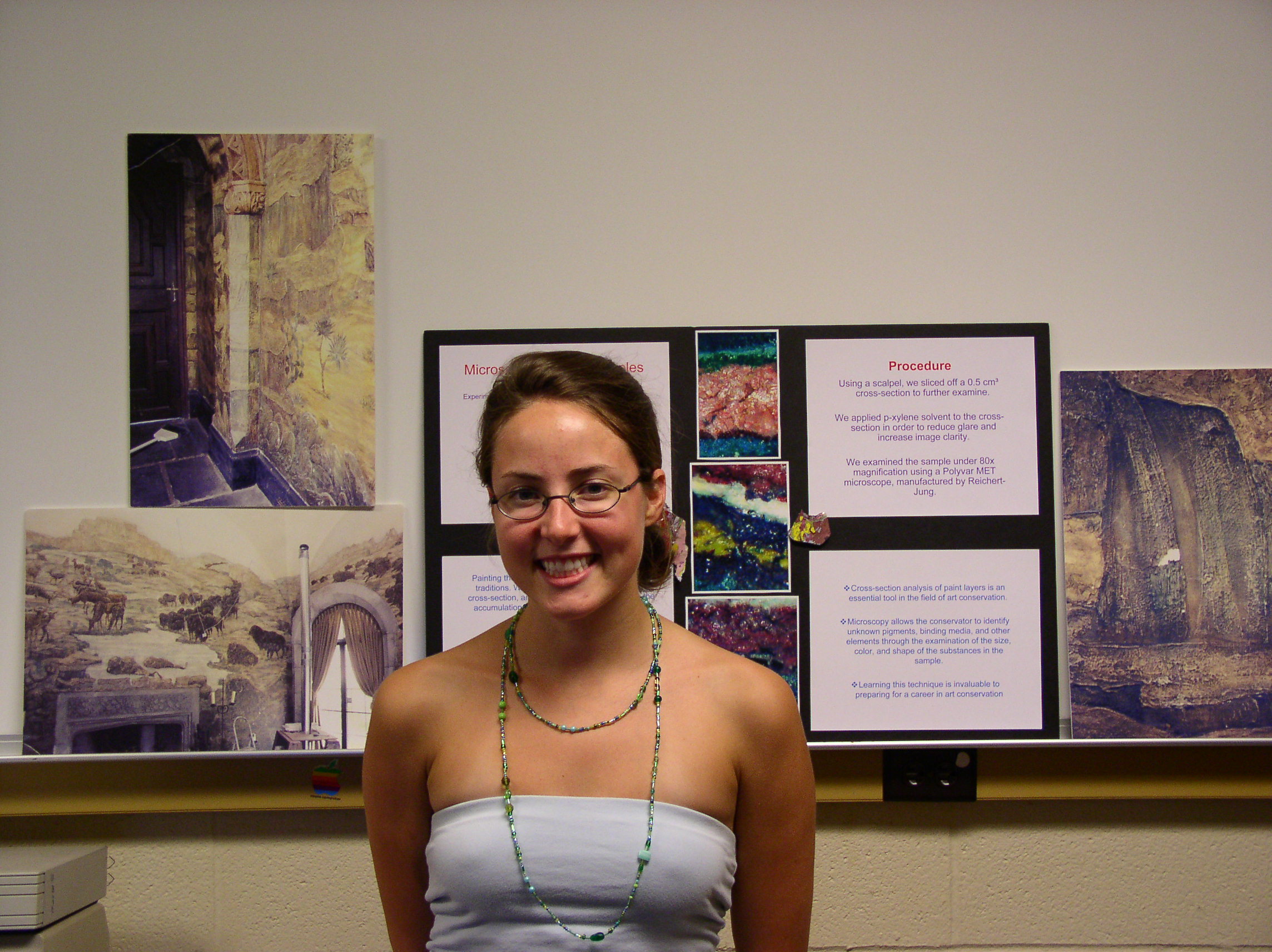Recent Student Projects/Research
2006-2007
HERRON, STEVE '09
Laser Ablation in Art Restoration
Advisor: Seyfollah Maleki
Laser ablation involves using a well-focused, high-powered pulsed laser beam to clean the surface of a solid material by literally vaporizing the surface contaminant by heating it to overcome the surface adhesion. However, the material surrounding the targeted area is relatively unchanged because the soiled material is ejected so quickly that it leaves no time for heat to transfer. Hence, laser ablation can be used to clean the surfaces without damaging the underlying material. Lasers operate on a single wavelength rather than on many wavelengths simultaneously, and the wavelength can be chosen accordingly so that it interacts with certain contaminants without affecting the surface being treated. One primary application of laser ablation is art restoration. On paintings, protective varnishes can fade to yellow and brown making the painting cloudy. In addition, dirt and soot can collect on the surface of a painting due to exposure to candles and air contaminants. Laser ablation is an effective means of cleaning statues of various mediums, which can collect dirt, corrosion lichen, and other types of corrosion. The purpose of this experiment was to analyze the effectiveness of laser ablation in cleaning several different surfaces and to investigate the properties, advantages, and disadvantages of laser ablation in art restoration.
MADDEN, SAM '07
SHG Characterization of NLO Dyes included within Laponite Nanoclay Films
Advisors: Seyffie Maleki (Physics) and Michael Hagerman (Chemistry)
Nonlinear optical (NLO) materials are used widely in the field of photonics because of their ability to perform sum- and difference- frequency generation as well as parametric amplification and oscillation. We have been working to characterize the second harmonic generation (SHG) properties of inorganic-organic hybrid nanocomposites. In our nanocomposite, an inorganic clay called Laponite was used as a host for the inclusion of a variety of neutral organic dyes with large molecular hyperpolarizabilities. We have been working to control the NLO response of the composites by varying the concentration of dye as well as the interlamellar clay cation. There are two types of dye aggregates that can form in these nanocomposites, J-type and H-type. J-type aggregation can lead to high SHG response because of the existence of permanent molecular electric dipoles while H-type aggregation leads to the cancellation of electric dipoles and no SHG signal. We have designed and built new SHG characterization instrumentation and collected preliminary SHG data on disperse red and disperse orange dyes included within Laponite nanoassemblies. These SHG measurements inform our ability to both understand and tune clay microenvironments that influence dye aggregation and have important implications for future photonic device applications.
.
GRANT, KATHRYN
Raman Spectroscopy for Pigment Analysis of Painted Artworks
Advisor: Seyffie Maleki
Raman spectroscopy is a technique used by highly trained conservators to identify paint pigments. The principle of Raman spectroscopy is based upon wavelength shift of non-elastically scattered photons from target molecules. Distinctive peaks specific to the molecule of interest arise in the wavelength analysis of such emissions. Scientists have identified the Raman spectra of sixty-four natural and synthetic pigments to which conservators compare results of their unknown samples. The novel benefit of this technique lies in its ability to, non-invasively, identify pigments directly from an area of the painted artwork. In our setup we use an argon-ion laser for the excitation of the sample. The scattered light is analyzed using a grating monochromator and a temperature cooled CCD. In our preliminary results we have successfully duplicated test data for a methyl chloride sample. We plan to present our data for paint pigment samples and compare them with those currently used by art conservators. • University College London , Chemistry Department. Raman Spectroscopic Library: http://www.chem.ucl.ac.uk/resources/raman/index.html
Return to Seyffie Maleki's page

MAZUR, TOM '07
Exploring the Quantum Behavior of Light Experimentally Via Spontaneous Parametric Downconversion
Advisor: Seyffie Maleki
Over the summer, we investigated the classical theory of optical coherence via experimentally measuring the degree of second-order coherence. This experiment transitioned into my thesis in which we consider a variety of experiments that demonstrate the quantum behavior of light. In particular, we attempt to illustrate the phenomenon of entanglement, show the existence of the photon via determining the degree of second order coherence when treating light quantum mechanically, demonstrate single-photon and two-photon interference, test a form of Bell 's inequality, and primitively teleport the state of a particle over some distance. All of these experiments rely heavily on spontaneous parametric downconversion in which a single photon of one frequency splits into a pair of photons upon traversing a nonlinear crystal. Conservation of energy and momentum govern the properties of these photons that exit the crystal. In fact, these laws of conservation yield photons that exhibit entanglement, a property that we repeatedly exploit in our experiments.

PEOPLE PHYSICS: AN EXAMINATION AND APPLICATION OF THE INTERSECTION OF PHYSICS AND SOCIOLOGY:
Advisors: Seyffie Maleki (Physics) and Jan Grigsby (Sociology)
INTRODUCTION Physics can be used to analyze and predict social life. At first glance, there does not seem to be a whole lot in common between Sociology and Physics, but upon closer examination, it becomes evident that they not only cover similar ideas, but Sociology actually branched off of Physics. Fundamentally, the two disciplines are closely linked, but we go about handling the information in such a different way that we can hardly recognize the similarity. In the following pages, we will look at a number of ways that the two sciences overlap and we will apply what we learn to help improve social life.
Sophomore Research Project - Advisor: Seyffie Maleki
The “Weirdness” of Quantum Mechanics
An examination in Physics & Philosophy
The Application of Physical Science to the Restoration of a Wall
Mural at Coe Hall, Oyster Bay, Long Island
Advisor: Seyffie Maleki